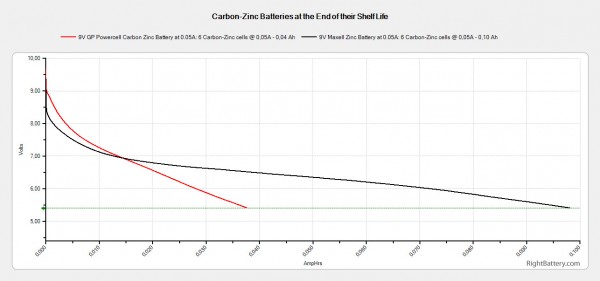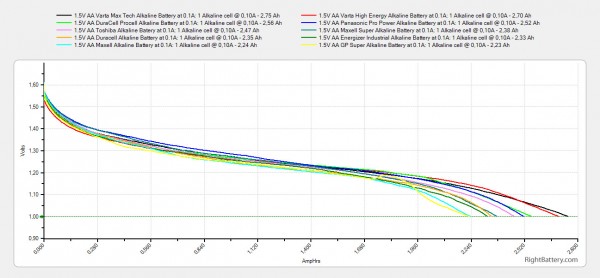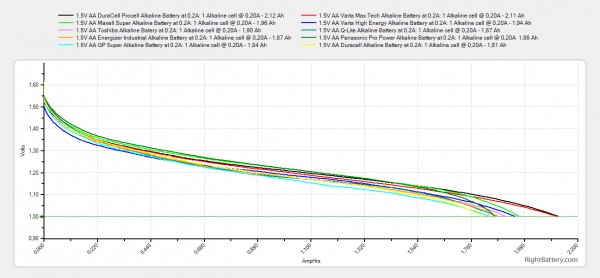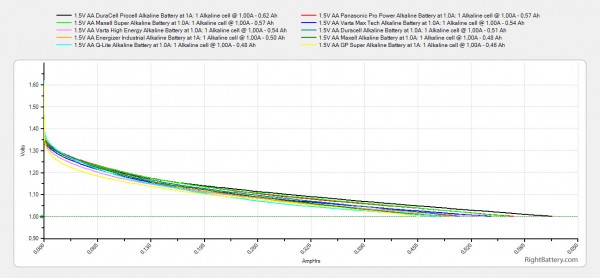RightBattery.com
Tests and reviews of different batteries to help you find the Right One…
Search
Posts Tagged ‘alkaline batteries’

One thing you should be very careful about is the expiration date of Carbon-Zinc and Alkaline batteries (primary batteries) as the closer the battery is to the end of its life cycle the less capacity it will be able to provide. More often than not when you pick a single use battery from a store you expect it to have a lot of time left before the expiration date is reached, so you don’t check the date printed on the battery, however this can be a mistake. Although Carbon-Zinc and Alkaline batteries usually have a low self discharge rate and long shelf life they are not going to perform so well when they are close to their expiration date as they would when they are new (usually 3-5 years after they were manufactured). The problem is more serious for Carbon-Zinc batteries that usually have less shelf life and offer lower capacity than Alkaline batteries, so you should be even more careful with these. And while some battery manufacturers may put a few months as an extra over the expiration date others may not, and there are also some additional factors that may influence the battery life such as the storage conditions and such. So in general you should check the battery expiration date when you buy primary batteries and if there are just a few months left you should not get them even if you do plan on using them immediately.

We’ve decided to test some Carbon-Zinc batteries that are either close to their expiration date or have already passed it, so after a bit of looking around we managed to actually buy such batteries – yes you can sometimes find expiring or even expired batteries still being sold in stores and these are usually Carbon-Zinc ones and not Alkaline. We got a 9V GP Powercell Carbon Zinc battery that expires in September 2013 (next month) and a 9V Maxell Zinc battery that has already expired in June and put them to a test using our test scenario for 9V batteries. This includes a constant discharge rate of 0.05 Ampers (50 miliamps) in order to measure what is the useable capacity we can get from these two batteries and the results we’ve got were quite surprising for us. The soon to expire 9V GP battery ended up hitting the cutoff voltage with just 38 mAh useable capacity and the already expired 2 months ago 9V Maxell battery still had 98 mAh. So even at the end of their life primary (single use) batteries may still be useable, however their useable capacity will be significantly less than what they are able to provide while new!
Common Consumer Batteries and the Names Used
4, Aug 2013
There are multiple battery sizes that are the most commonly used ones, these are the AAA, AA, C, D and 9V batteries that can be either primary (single use) as well as rechargeable. But these batteries also have many other names, some of which are used by different manufacturers and in some countries the other names may be more popular than the typical types mentioned above.
AAA Alkaline Battery – MN2400, LR03, E92, 4203/4003, K3A, AM4, 824, LR03, 24A, R03 (carbon–zinc), 24D (carbon–zinc)
AAA Rechargeable Battery – HR03 (NiMH), MIGNON, MINI-STILO, 4003, E92, K3A, R0, UM4, KR03 (NiCd), ZR03 (NiOOH)
The typical capacity of an AAA size alkaline battery is around 1000-1200 mAh, for Carbon-Zinc batteries the capacity is around 500 mAh and the rechargeable AAA batteries of the NiMH type usually offer abound 800-1000 mAh capacity.
AA Alkaline Battery – MN1500, LR6, E91, 4206/4006, KAA, AM3, 815, LR6, R6 (carbon–zinc), 15D (carbon–zinc)
AA Rechargeable Battery – HR6 (NiMH), MICRO, STILO, 4006, E91, KAA, R6, UM3, KR6 (NiCd), ZR6 (NiOOH)
The typical capacity of an AA size alkaline battery is around 1500-2500 mAh, for Carbon-Zinc batteries the capacity is around 500-800 mAh and the rechargeable AA batteries of the NiMH type usually offer abound 1600-2900 mAh capacity.
C Alkaline Battery – MN1400, LR14, E93, 4014, KC, AM2, 814, LR14, R14 (carbon–zinc), 14D (carbon–zinc)
C Rechargeable Battery – HR14 (NiMH), BABY, MEZZA-TORCIA, 4014, E93, KC, R14, UM2, KR14 (NiCd), ZR14 (NiOOH)
The typical capacity of a C size alkaline battery can be up to about 8000 mAh, for Carbon-Zinc batteries the capacity can be up to about 4000 mAh and the rechargeable C batteries of the NiMH type usually offer abound 4500-6000 mAh capacity. Alternatively there are also special plastic adapters that can be used together with an AA battery to make a C size cell, though the capacity would be lower in this case than what a C size battery would normally provide.
D Alkaline Battery – MN1300, LR20, E95, 4020, KD, AM1, 813, LR20, 13D (carbon-zinc), R20 (carbon-zinc)
D Rechargeable Battery – HR20 (NiMH), HR20, MONO, TORCIA, 4020, E95, KD, R20, UM1, KR20 (Ni-Cd), ZR20 (NiOOH)
The typical capacity of a D size alkaline battery can be up to about 12000 mAh, for Carbon-Zinc batteries the capacity can be up to about 8000 mAh and the rechargeable D batteries of the NiMH type usually offer abound 2000-12000 mAh capacity. Alternatively there are also special plastic adapters that can be used together with an AA battery to make a D size cell, though the capacity would be lower in this case than what a D size battery would normally provide.
9V Alkaline Battery – MN1604, 6LR61, 522, 4022, K9V, 6AM6, A1604, 6LR61, 1604D (carbon‑zinc), 6F22 (carbon-zinc), 1604LC (lithium)
9V Rechargeable Battery – HR9V (NiMH), HR9V, E-BLOCK, TRANSISTOR, 422, 4022, 6F22, K9V, 6HR61, 6KR61 (NiCd), 11604 (NiCd)
The 9V batteries essentially consists of multiple cells to bring up the voltage higher – 6x 1.5V cells for carbon-zinc; 3 cells for Lithium; 6, 7 or 8 cells for NiMH (7.2V, 8.4V or 9.6V) using 1.2V cells. Alkaline batteries can go up to about 500-600 mAh capacity, 400 mAh for the carbon‑zinc, up to about 1200 mAh for lithium (non-rechargeable), 200–300 mAh for NiMH and about 100 mAh for NiCd.
- In: Useful Battery Articles
- Tags: 9V, aa, AAA, alkaline batteries, battery names, C, carbon-zinc, D, lithium, NiCd, nimh, rechargeable batteries




